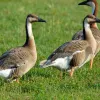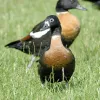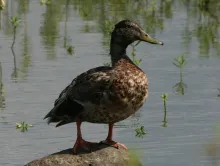
Hawaiian duck (Anas wyvilliana)
Naamgeving
- Nederlandse naam:
- Hawaii eend
- Engelse naam:
- Hawaiian Duck
- Duitse naam:
- Hawaiiente
- Franse naam:
- Canard d'Hawaii
- Wetenschappelijke naam:
- Anas wyvilliana
Taxonomische indeling
- Orde:
- Anseriformes
- Familie:
- Anatidae
- Onderfamilie:
- Anatinae
- Geslacht:
- Anas
Beschrijving
- Uiterlijke kenmerken:
Male:
Crown and hindneck blackish brown with varying amounts of green iridescence ,though not strongly so as head sometimes merely dark brown with or no green. Pale buff supercilium above dark-eye stripe, though neither of these is well defined, with pale eye-ring. Cheeks, throat and neck paler brown. Breast Rufous to purplish-brown with small, blackish spots, but can be more heavily marked. Rest of underparts warm brown, marked black and buff, with markings on flanks producing strong scalloping or, often, wavy vertical barring; more spotted on belly, vent and under tail converts. Mantle and scapulars with dark centers and broad paler edgings, but tertails paler grey-brown and unmarked; rump and upper tail coverts blackish. Tail grey, with whitish sides, sometimes brownish, the central feathers being slightly up curved. Upperwing mainly dark grey- brown, with green speculum bordered in front with whitish-buff and behind with black and then white; underwing whitish, with brown flight feathers. Bill is olive-grey, with black nail and darker base and center to upper mandible. Legs and feet orange.Female:
Breast slightly warmer, reddish-brown and eye stripe sometimes less distinct. Bill is dusky grey brown, with fleshy yellowish orange behind nail and short distance up sides of upper mandible. Legs and feet orange.Juvenile:
Duller brown with more diffuse markings on body.
- Gedrag:
Gregarious except while breeding. Found in sizeable groups in winter. Pair bonds formed between November and May.
Maten en Gewicht
- Lengte man:
- De man (woerd) van de Hawaiian duck heeft een lichaamslengte van ongeveer 44-49 centimeters. De vrouw (pop) heeft een lichaamslengte van ongeveer 44-49 centimeters.
- Gewicht man:
- Het mannetje weegt ongeveer 670 gram. Het vrouwtje weegt ongeveer 570 gram.
Het gewicht is notoir variabel en kan alleen als indicatie worden gebruikt!
- Notitie:
Dabbling Ducks are generally hardy, easy to maintain and easy to breed. Shelter may be required by some of the smaller species in winter. They should be provided with cover (including marginal pond cover) and loafing areas as well as water. A pen which is 50% water is suggested. The water may be shallow (i.e. no more than two feet deep is required), and muddy areas for dabbling in are also appreciated. These ducks are generally good in mixed collections, although the smaller and quieter species may be bullied. Territorial disputes between ducks of the same species may be avoided by keeping only one pair of each species in an enclosure, unless the area is very large. For a single pair of ducks a pen are of 50 to 100 square metres, depending on the size of duck, should be provided.
A diet based on wheat and pellets is suggested, with maintenance pellets changed to breeders pellets for the breeding season. Bread and greenfood are also appreciated. Grit should always be available, with soluble grit (e.g. oystershell grit) as a calcium source when breeding.
Most species are ground nesters and both close ground cover and ground level nest boxes should be provided. Hand-rearing is generally preferred, as these ducks are generally poor parents in captive conditions, particularly in enclosures shared with other waterfowl. These ducks are prone to hybridization, particularly with closely related species, which should be kept apart from one another.
Hawaiian ducks are not difficult to keep; cover and loafing areas should be provided as well as water.
These ducks are easy to breed. They usually lay from April to June, in close ground cover or ground-level nest boxes.
This duck readily hybridises with Laysan duck (Anas laysanensis). Should be kept separate from this species and other closely-related (mallard-type) species to avoid hybridisation.
- Breeding:
- Het vrouwtje Hawaiian duck legt doorgaans zo'n 8-10 greenish-white eieren het broeden duurt 26-28 dagen.
- Kunstmatig broeden:
De ideale relatieve luchtvochtigheid voor het uitbroeden van de meeste watervogeleieren is 55% voor grondbroeders en 40% bij holenbroeders. De temperatuur is meestal 37,4° C. Stel ventilatie in zoals aanbevolen door de fabrikant van de broedmachine. Eieren moeten minimaal 4 keer per dag automatisch of met de hand worden gedraaid. Naarmate de vrucht zich ontwikkelt, verliest het ei water en wordt de luchtzak groter. Bij normale ontwikkeling van een ei met een incubatietijd van 26-28 dagen neemt de luchtzak ongeveer een derde van het ei in beslag, dit bij drie dagen voor uitkomst. Reinheid is van vitaal belang en idealiter moet de luchtvochtigheid worden verhoogd tot 65% nadat de eerste tekenen van uitkomst zichtbaar worden.
- Ringdagen:
- Aanbevolen passende ringmaat voor de Hawaiian duck is 9 mm.De gesloten pootring kan alleen aangebracht worden bij een jonge dabbling duck van ongeveer 10-11 dagen oud.
- It doesn't matter what leg that you band, but it's good to have a consistent system. Suggested: Left leg = Female, Right leg = Male
- Onderhoudsvoeder:
-





Lundi Regular with a protein content of 20%, valuable Spirulina and high-quality by-products is optimally balanced in its composition maintenance food for water ornamental fowl of all kinds. Especially green teal and Whistling ducks that are not dependent on a very high protein content, are well supplied.
Lundi Regular contains all the minerals and vitamins in full form that are important for the animals. Therefore also suitable as breeding food.





Floating full food for all sea ducks, green ducks, eider ducks and geese, especially in the moulting and breeding phase ideally suited. Packed with wholesome raw materials, natural vitamins and trace elements, this performance food with a protein content of 30% forms the basis for lifelong vitality.


